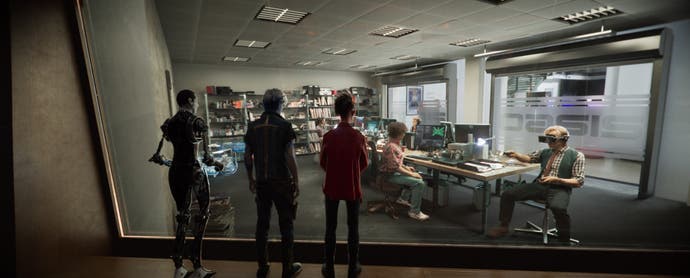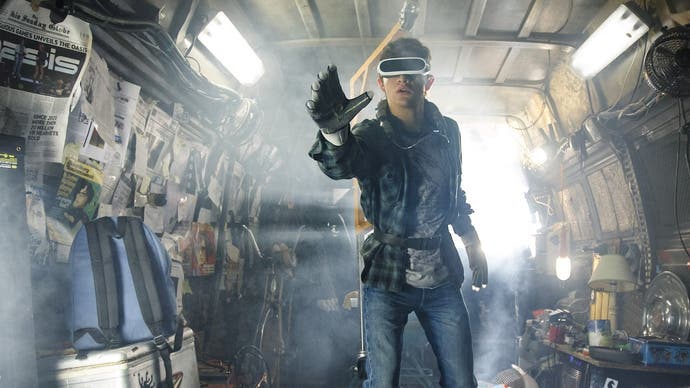Ready Player One film review - garish and nostalgic, but Spielberg gets games
Pop culture will eat itself.
To call Ready Player One - Steven Spielberg's new film, adapted from the novel by Ernest Cline - self-referential would be quite an understatement. It's a mind-warping cultural Möbius strip: a one-dimensional entity with no end and no beginning, permanently twisting in on itself. It's a futuristic work of science-fiction that is obsessed with nostalgia. It's a film about video games made by a director who was a huge formative influence on the medium, observing his own reflection in a funhouse mirror. It's what happens when fan fiction becomes dominant over the true works of imagination it pays homage to.
This makes it sound self-involved and meaningless, and that is what I expected it to be: a more polished version of Chris Columbus' patronising nerd fantasy Pixels. But the thing is that Ready Player One was directed by Steven Spielberg, and though the great director's best work is behind him, he is still an uncommonly lucid storyteller with a sure sense of what technology can do for him and what it can't. He knows how to spin a fun adventure yarn. And he gets video games.
In the year 2045 - "after the great corn syrup drought and the bandwidth riots" - Earth's underemployed and overcrowded population lives in slums and has little to do. Just about everyone deals with this grotty, boring existence by slipping on VR headsets and escaping into the OASIS, a virtual world created by the game designer James Halliday (Mark Rylance), now deceased and worshipped as a demigod. The OASIS is many games within one. It's the ultimate MMO, where players can be whoever or whatever they want to be as long as they participate in a ruthless digital economy to earn 'coin'.

Elite players participate in a game-within-the-games-within-a-game, hunting for three keys that will lead to the ultimate prize: an Easter Egg that will grant the bearer controlling shares in the Halliday's company, and thus control of the OASIS itself. To do this they need skill and courage, but they also need to steep themselves in the lore of Halliday's life and his consuming obsession with 1980s pop culture. Orphaned Ohio teenager Wade Watts (Tye Sheridan) is engaged in this hunt, as are the celebrity player Art3mis (Olivia Cooke) and a nefarious rival corporation, IOI. IOI makes the hardware most people use to access the OASIS; it sells it on credit and then arrests customers who default on their debts, locking them up in "loyalty centres" where they perform forced labour in VR, physically toiling in the (bit)coin mines.
This idea has genuine satirical bite. But Spielberg is content to play IOI as pantomime villains and leave the dark prophesying about an AI-powered economy turning humans into the cogs in the machine as a muted subtext. Because - look! Over there! It's the DeLorean from Back to the Future and the bike from Akira! And there's King Kong, and there's the Iron Giant! Listen: Van Halen and Hall & Oates on the soundtrack! Jokes about John Hughes and Mario Kart in the script!
Ready Player One is a dense, unrelenting blizzard of pop culture iconography and reference. Every frame is crammed with posters and badges and walk-on cameos from infinite fictional universes. Action scenes are surreal, swirling collages of other people's heroes fighting each other - an astronomically expensive version of a kid smashing mismatched action figures together on the living room carpet. It does make a kind of sense in context. Many denizens of the OASIS model their avatars after their personal favourites (Beetlejuice! Tracer!), while Halliday's preoccupations have become those of his acolytes in the wider population. If he is to be their god, then Star Trek, Dungeons & Dragons and A-ha's Take On Me will be their bible.

It's a lot, though - maybe too much. A post-modern magpie like Quentin Tarantino might revel in his own retro references - spaghetti westerns, kung fu, blaxploitation - but he also internalises them to the extent that his films become more than homage and take on a weird life of their own. Cline (who co-wrote the screenplay) and Spielberg don't seem to be interested in anything more than atomising geek nostalgia and sprinkling it across the movie like a gaudy cake topping. This must have been great news for an army of Hollywood intellectual property lawyers - and it seems it's a favoured approach at Warner Bros. these days, going by the franchise pile-on that was The Lego Batman Movie. It's a superficial sort of fun, but personally I don't draw any validation or meaning from hearing a namecheck for GoldenEye, or from seeing five Master Chiefs romping across a cinema screen.
Spielberg, thankfully, is canny enough not to lean too heavily on the nerd parade. Look beneath it and you'll find a fundamentally well-constructed adventure movie, with excitement, laughs, romance, astonishing single-shot digital action sequences (much like the bravura shots in his The Adventures of Tintin), plausible performances, well-judged stakes and a strong narrative motor. And beyond the brief flashes of games as variously well known as Minecraft, Trackmania and Battletoads, you'll find a movie that is structured like a game, that largely takes place inside of one, and that understands what video games are and why people play them.
The OASIS is fantastical - not least because it seems to be a place where intellectual property law holds no sway. But it's built out of concepts that will make sense to any Eurogamer reader: online identities, modding, in-game stores, item rarity, clans. Ready Player One acknowledges that the escapism, mastery and self-projection offered by a game world can have real value to people. It also understands that not everyone plays games to win, and that exploring these worlds to unearth their secrets is just as powerful a pull. This point is made at the film's climax with a scholarly reference that reaches deep into gaming's past and, for once, feels more substantial than a fleeting bit of trivia.

Ready Player One doesn't condescend to gaming, or look to borrow its iconographic power without understanding where that power comes from. The film is, it has to be said, spectacularly ugly, but even this seems on point: Wade's avatar, Parzival, with his feathery blue hair, looks like a particularly gauche Final Fantasy character, but isn't that how a teenage boy would choose to represent himself? Accidentally or not, the production design nails the chaotic overstatement of an anything-goes virtual world like Second Life.
Tellingly, though, Ready Player One's most audacious visual moment draws on film, not games. For the second challenge, Wade and his friends enter the world of a revered classic movie, which is recreated with astonishing accuracy - not just the sets and the lighting but how they looked on 35mm film. It seems almost sacrilegious to see their garish avatars capering about a setting that has been seared into our collective consciousness for decades. It leaves quite an impression; I don't think any director other than Spielberg could have got away with this. Video games, says Ready Player One, Hollywood loves you really - it just loves itself a little bit more.
Still, Ready Player One is a far more authentic video game movie than Pixels, or most other predecessors. It's a more enjoyable film in its own right, too. It's a shame that it can't find more to say about the strange new human habit of virtual living; the moral of the story amounts to little more than one of those messages in a Nintendo game telling you to take frequent breaks. And yes, its slavish regard for bygone geek entertainments - an indulgence in which it is hardly alone - speaks of an unhealthy, hermetic urge to bury ourselves in the fantasies of our childhood (although this is subtly acknowledged in an affecting late scene with Rylance). But such cultural commentary is more than we should expect of a frothy thrill-ride such as this. What we do have is Spielberg, arguably the great popular artist of the last 40 years, tipping his hat graciously to the young medium that burst into noisy life in parallel with his career. Right back at you, Steven.









